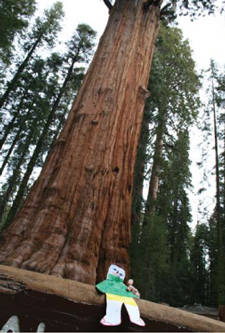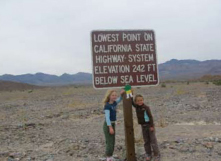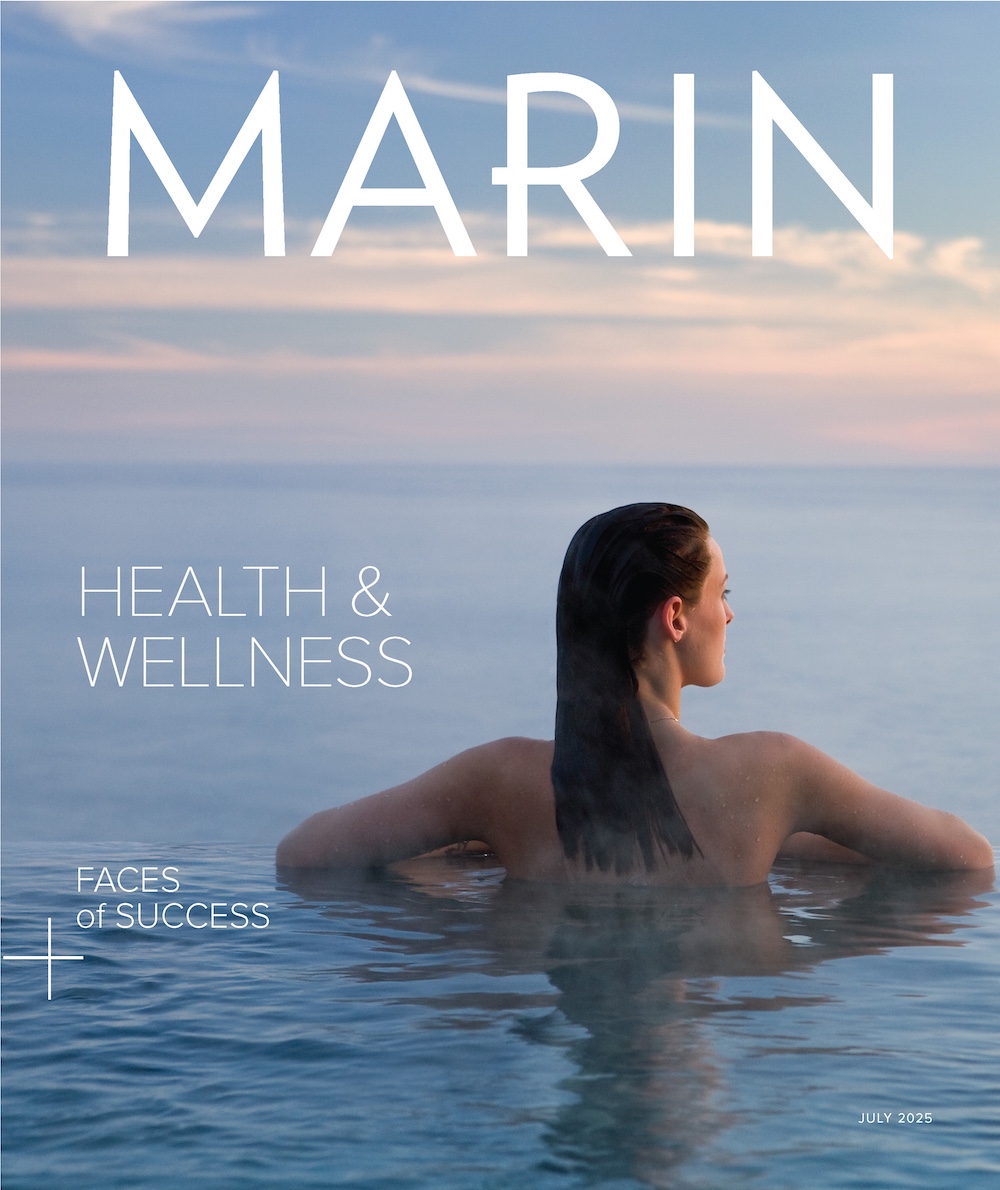For spring break this year, we had intended to join friends at our favorite Hawaiian resort on the Big Island. But our budget had other plans. We had bled our savings (and line of credit) on a remodel and my husband, Pete is, ahem, “between jobs,” so we balked at spending money we didn’t have.
Enter Plan B.
Pete, possibly inspired by the grainy super-8 home movies of his childhood or a desire to reprise Chevy Chase’s character in Vacation, suggested an old-fashioned road trip. We decided to do California, traversing the state from the Golden Gate to the high desert. To soften the blow about Hawaii, we pitched the new adventure to the kids as a series of “ests,” as in: “We’re going to go see the largest tree in the world, the lowest point in the United States, the second-hottest place on the planet.” The response was less than ecstatic.
“Are the Bacinos going too?” my five-year-old asked.
“No, but we’re going to see some amazing things, and we’ll spend almost two weeks together and,” I paused for effect, “we’ll go
swimming.”
On the map, the road from Marin to our first stop, Sequoia National Park, looked exciting, less traveled, even exotic. And by exotic I don’t mean tropical. I mean (with many thanks to Webster’s) strikingly, excitingly or mysteriously different or unusual. “We’ll head to Fresno and turn left,” said Pete. Simple enough.
I don’t mean tropical. I mean (with many thanks to Webster’s) strikingly, excitingly or mysteriously different or unusual. “We’ll head to Fresno and turn left,” said Pete. Simple enough.
To ensure a harmonious journey, I went online to learn how to keep the peace between our girls, Natalie, 5, and Grace, 8. “Don’t allow videos,” one website warned. “They can isolate the children. Instead, do activities like the license plate or alphabet game.” But another site cautioned me not to plan too many things in a day. “Spend time at the hotel pool,” it suggested. We have plenty of pool time here in Marin, I thought to myself.
On getaway day, Natalie could barely contain herself when we picked up the girls from school. “We’re going to Death Valley, Ms. Marks,” she said, skipping down the hall.
“Don’t brag,” her older sister scolded in a whisper.
A few minutes later, nibbling Itty Bitty Beanies from High Tech Burrito and looking out the car window, both girls were smiling as we left Marin over the Richmond–San Rafael Bridge.
“First stop, General Sherman!” I announced. We had already prepped them with particulars. This giant sequoia is 275 feet tall, its trunk weighs 1,385 tons (more than two 747s) and is 103 feet in circumference, making it the largest tree in the world.
It takes a while—about four hours—for Highway 99 to lose its banality, for the repetitive sight of teens gathered at mini-marts to give way to something resembling picturesque, like a run-down barn with “Art Gallery” painted on the door in blue. Eventually, hypnotic groves of orange trees appear, stretching across the Visalia horizon. Interesting, but not big tree country. “Did we miss a turn?” I asked. Pete shook his head, as he continued talking into the earpiece connected to his Blackberry. The girls didn’t seem to mind the long drive. They were giggling, glossy- eyed after watching Air Buddies for the second time. I grabbed Pete’s free hand in mine and returned my stare to the window.
We arrived at Sequoia National Park about six o’clock, paid our $20 entrance fee and followed a narrow, steep, two-lane road up Ash Mountain to Wuksachi Lodge. This eight-year-old Craftsman-style lodge, perched at 7,200 feet in the heart of the park, has a decent restaurant, meeting spaces, a gift shop and Wi-Fi. The accommodations themselves are a short walk or drive from the lodge and are set back from the parking lot (no bellhop to help you to the rooms). Our room was perfectly comfortable for the night—especially since we’d brought our own pillows.
By 8 a.m., we’d repacked the car and enjoyed the breakfast buffet. As the first visitors to the Giant Forest parking lot (home to General Sherman), we had unfettered access to everything the small park with the big trees had to offer. It’s hard to judge whether the girls truly understood the profundity of their encounter. They seemed more interested in the photo opportunities with Flat Stanley (the paper doll Natalie made in kindergarten, which we brought along) than acknowledging their brush with great sequoia-ness. They were equally blasé in the visitor center, where the life cycles of the giant sequoias, sugar pines and coastal redwoods are celebrated and explained via videos and hands-on learning centers. That was fine, since we wanted an early start for our next leg of the trip, which Google Maps forecasted as a seven-hour, 28-minute journey.
After six car-bound hours the previous day, we had a new strategy: each “are we there yet?” would cost the girls a quarter; they had to play cards (or something) for 30 minutes between each video; and food and drink intake would be limited to reduce the potty breaks. We cruised through industrial Bakersfield onto Highway 58, where we drove past the rolling hills of Tejon Ranch and pulled off for a delicious Thai lunch in Tehachapi. As the miles piled up, green faded to the muted colors of the desert.
“Amazing,” muttered Pete as we entered yet another desolate, rocky eastern Sierra valley.
“Is this it?” I asked, after driving for what seemed like forever. “Girls, check it out—Death Valley.”
They looked up from their card game of War and briefly scanned the horizon.
Actually, we were still one valley and 90 minutes away. That was okay. I was enjoying sitting next to my husband, whom I rarely see at home. A glimmering spot on the horizon slowly became the blink-and-you’ll-miss-it town of Trona, population 1,885, just outside Death Valley.
There aren’t many places to stay in Death Valley, and our last-minute planning landed us at the Furnace Creek Ranch. At $173 a night, I figured it would be decent. I was barely correct. After walking into room number 837, feeling damp carpet under my toes, wondering what had stained the bathroom fixtures and escaping the angry hornet I had dislodged from its nest on our six-by-two-foot balcony, I tried in vain to switch us to the rooms across from the chain-link-fenced pool. After fruitlessly checking availability at the more-luxe Furnace Creek Inn up the road—no luck—we moved into our funky-smelling accommodations.
The girls were impatient with our lollygagging; they couldn’t wait to join the masses in the pool. Within minutes we were a part of the chlorine-frenzied mob. Pete found an unclaimed lounge chair and we both sat on it, silently taking in the sights and the warm air. I overheard my youngest talking to a new friend in a Disney-princess one-piece: “I don’t know what you’re saying?” Her new buddy spoke German, as did most of the people around us. Luckily, the games Marco Polo and “jump like me” don’t require a shared language. I went to the gift shop, bought some ice-cold Miller Light, and returned to Pete to watch the desert sunset.
Just what to visit in this 3.3 million-acre national park was determined by proximity. After reading the brochures, I decided my goal was to summit the 80-foot Stovepipe Wells dunes hand-in-hand with the family and then enjoy the slide down. Unfortunately, by ten in the morning, the temperature was already in the 90s.
“I’m gonna die,” said Natalie, her fine hair matted to her forehead with sweat. “I can’t walk another step.” This was a bad sign, since we hadn’t officially reached the trail to the sand dunes. As a good mommy martyr, I sent Pete and Grace on their way. “I’ll wait for you here,” I assured them, securing a wisp of shade under a prickly mesquite tree. They returned in defeat, just about the time Natalie had regained her composure.
After a stop at the Stovepipe mini-mart and fueling up on Gatorade, I thought I’d try for one more highlight before lunch. “Check it out,” I said as I pulled the car into an empty parking lot. “This is where the 20-mule Borax stuff we use at home comes from.” Not technically accurate, but I thought it might get them out of the car.
 Even a trip to Badwater Basin, the lowest spot in the Northern Hemisphere (282 feet below sea level), didn’t rouse their interest. We went back to the pool—and this time I jumped in, too, wearing shorts and tank top.
Even a trip to Badwater Basin, the lowest spot in the Northern Hemisphere (282 feet below sea level), didn’t rouse their interest. We went back to the pool—and this time I jumped in, too, wearing shorts and tank top.
Driving south out of the park, we passed Zabriskie Point, setting for the infamous 1970 counterculture film, and now a popular sunrise hiking spot. Even from the highway, we enjoyed the stunning reds, pinks and grays of the early morning light on the surrounding mountains.
“Next stop, La Quinta!” and I didn’t mean the hotel chain, but the resort hotel.
That we chose Coachella Valley during spring break only proves we hadn’t truly thought though our timing. The contrast between deserted Death Valley (even at high season) and this thriving metorpolis, which includes the towns of Palm Springs, Palm Desert and La Quinta, was alarming. Taking in the endless construction and the seemingly boundless supply of water, I wondered if these people had heard of skin cancer. Everyone was tan, really tan, and as they played tennis and golf in the intense sun, they continued tanning.
La Quinta Resort is about 30 minutes down Highway 111 from Palm Springs. The town of La Quinta was named after the resort, which was established in 1926 as a haven for the rich and famous of Hollywood—who apparently still visit. Britney Spears and her crew were spotted here as well as Kevin Costner (not with Brit) to name a few. Casitas are set around smallish pools, providing a festive, sociable atmosphere. There are two larger pools, tennis courts, golf and a world-class spa. During spring break, forget about landing a shaded cabana or even a lounge chair at the big pools unless you show up early. We ended up sticking by the pool next to our casita. Waiting for our lunch, we ran into friends from Marin. They too had originally planned on a Hawaiian vacation but, since their kids were still young, decided warm weather and a pool was all they really needed.
Pete and I took turns watching the girls, and when I had some free time I joined a history walk with longtime concierge Buck, who pointed out that the tiles on the roofs of the original casitas were shaped over the legs of the Mexican tile makers. “Some of ’em were big guys, and some pretty skinny,” Buck explained. “That’s why they’re so uneven.” We also passed by the casita frequented for many years by the legendary Frank Capra. He stayed here when he tinkered with scripts like Mr. Smith Goes to Washington and other classics. “His original typewriter is still in there,” Buck said. I also enjoyed an afternoon at the spa. I steamed, I tubbed and I indulged in the Seduction of the Senses treatment (voted best facial by Palm Springs Life magazine).
At La Quinta, we never left the property. Some friends with a weekend home in nearby Palm Desert joined us for dinner upstairs at the Adobe Grill. We dined at Twenty6. We worked out in the fitness center and we were even tempted to take up golf, just to be able to tour the beautiful courses surrounding the property.
La Quinta living was good, and when the day came to leave we weren’t ready. We bid farewell to our new pool friends and piled back into the car. The drive home was quiet.
Three hotel rooms, four books-on-tape, two videos and 1,890 miles since we began our journey, I spied Mount Tam again. As we crossed the San Rafael Bridge, I glanced in the rearview mirror at the girls in the backseat.
“We’re home,” I said.
“Can we go swimming?” Grace asked.
Who is Flat Stanley?
Inspired by the book Flat Stanley by Jeff Brown, over 6,000 classrooms around the world have participated in the Flat Stanley Project. Students create these two-dimensional travelers and send them to a friend. Flat Stanley’s journey teaches the children about different parts of the world. Our “Stan” witnessed various points of interest in the desolate evaporated Pleistocene era lake bed of Death Valley, sidled up to the world’s largest tree and enjoyed the good life at the La Quinta Resort.
Planning a trip?
Check out these websites for lodging information.
Wuksachi Lodge:
sequoia.com/lodging
Death Valley:
furnacecreekresorts.com
La Quinta:
laquintaresort.com

Mimi Towle has been the editor of Marin Magazine for over a decade. She lived with her family in Sycamore Park and Strawberry and thoroughly enjoyed raising two daughters in the mayhem of Marin’s youth sports; soccer, swim, volleyball, ballet, hip hop, gymnastics and many many hours spent at Miwok Stables. Her community involvements include volunteering at her daughter’s schools, coaching soccer and volleyball (glorified snack mom), being on the board of both Richardson Bay Audubon Center. Currently residing on a floating home in Sausalito, she enjoys all water activity, including learning how to steer a 6-person canoe for the Tamalpais Outrigger Canoe Club. Born and raised in Hawaii, her fondness for the islands has on occasion made its way into the pages of the magazine.


